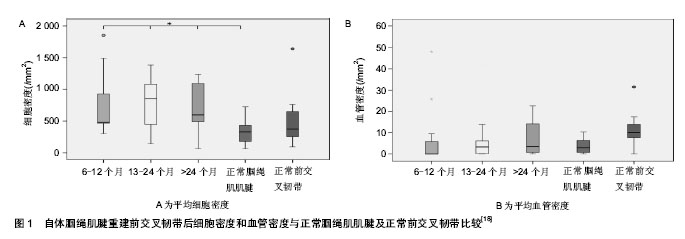| [1] Armour T,Forwell L,Litchfield R,et al.Isokinetic evaluation of internal/external tibial rotation strength after the use of hamstring tendons for anterior cruciate ligament reconstruction. Am J Sports Med.2004;32(7):1639.
[2] Tadokoro K, Matsui N, Yagi M, et al.Evaluation of hamstring strength and tendon regrowth after harvesting for anterior Cruciate ligament reconstruction. Am J Sports Med. 2004; 32(7): 1644.
[3] Gerber JP, Marcus RL, Leland ED, et al.The Use of Eccentrically Biased Resistance Exercise to Mitigate Muscle Impairments Following Anterior Cruciate Ligament Reconstruction: A Short Review. sportshealth. 2009;1(1):31-38.
[4] Nakamura N, Horibe S, Sasaki S, et al. Evaluation of active knee flexion and hamstring strength after anterior cruciate ligament reconstruction using hamstring tendons. Arthroscopy. 2002;18(6):598.
[5] Adachi N,Ochi M,Uchio Y,et al.Harvesting hamstring tendons for ACL reconstruction influences postoperative hamstring muscle performance. Arch Orthop Trauma Surg. 2003;123(9):460.
[6] Gibson A, Lambert M, Durandt J, et al.Quadriceps and hamstrings peak torque ratio changes in persons with chronic anterior cruciate ligament deficiency. J Orthop Sports Phys Ther.2000;30(7):418.
[7] Keays SL, Bullock-Saxton JE, Keays AC, et al.A 6-Year Follow-up of the Effect of Graft Site on Strength, Stability, Range of Motion, Function, and Joint Degeneration After Anterior Cruciate Ligament Reconstruction. Am J Sports Med.2007;35(5):729-738.
[8] Tadokoro K, Matsui N, Yagi M, et al.Evaluation of hamstring strength and tendon regrowth after harvesting for anterior Cruciate ligament reconstruction.Am J Sports Med. 2004; 32(7): 1644.
[9] Ristanis S, Tsepis E, Giotis D, et al. Electromechanical Delay of the Knee Flexor Muscles Is Impaired After Harvesting Hamstring Tendons for Anterior Cruciate Ligament Reconstruction. Am J Sports Med.2009;37(11):2179-2186.
[10] Ristanis S, Tsepis E, Giotis D,et al. Knee flexor muscle responses under fatigue after harvesting the hamstrings for anterior cruciate ligament reconstruction. Clin J Sport Med. 2011,21(4):288-293.
[11] Georgoulis AD, Ristanis S, Papadonikolakis A, et al. Electromechanical delay of the knee extensor muscles is not altered after harvesting the patellar tendon as a graft for ACL reconstruction: implications for sports performance. Knee Surg Sports Traumatol Arthrosc.2005;13: 437-443.
[12] Muraoka T, Muramatsu T, Fukunaga T et al. Influence of tendon slack on electromechanical delay in the human medial gastrocnemius in vivo.J Appl Physiol. 2004;96(2):540-544.
[13] 刘晓鹏,安华,于长隆应用等速肌力测试评价膝前交叉韧带断裂重建术后康复的效果[J].中国运动医学杂志,2008,27(3): 286-289.
[14] Eitzen I, Eitzen TJ, Holm I, et al.Anterior Cruciate Ligament–Deficient Potential Copers and Noncopers Reveal Different Isokinetic Quadriceps Strength Profiles in the Early Stage After Injury.Am J Sports Med.2010;38(3):586-593.
[15] 高凯,王予彬,王惠芳.前交叉韧带损伤与重建术后的等速肌力评价[J].中国康复医学杂志,2006,21(5):467-469.
[16] Desnica Bakrac N. Dynamics of muscle strength improvement during isokinetic rehabilitation of athletes with ACL rupture and chondromalacia patellae. J Sports Med Phys Fitness.2003;43(1):69.
[17] Svensson M, Kartus J, Ejerhed L,et al. Does the Patellar Tendon Normalize After Harvesting Its Central Third?.Am J Sports Med.2004;32(1):34-38.
[18] Janssen RP, van der Wijk J, Fiedler A, et al.Remodelling of human hamstring autografts after anterior cruciate ligament reconstruction.Knee Surg Sports Traumatol Arthrosc. 2011; 19:1299-1306.
[19] Shelbourne KD, Johnson BC.Johnson. Effects of Patellar Tendon Width and Preoperative Quadriceps Strength on Strength Return After Anterior Cruciate Ligament Reconstruction With Ipsilateral Bone-Patellar Tendon-Bone Autograft. Am J Sports Med.2004;32( 6):1474-1478.
[20] 许树柴,王盛贤,刘军.前交叉韧带重建后康复方案选择的若干争议[J].中国中医骨伤科杂志2008,16(9):67-69.
[21] Sekir U, Gur H, Akova B.Early Versus Late Start of Isokinetic Hamstring-Strengthening Exercise After Anterior Cruciate Ligament Reconstruction With Patellar Tendon Graft. Am J Sports Med.2010;38(3):492-500.
[22] Shelbourne KD, Klotz C.What I have learned about the ACL: utilizing a progressive rehabilitation scheme to achieve total knee symmetry after anterior cruciate ligament reconstruction. J Orthop Sci.2006;11:318-325.
[23] Tagesson S, Oberg B, Good L,et al. A Comprehensive Rehabilitation Program With Quadriceps Strengthening in Closed Versus Open Kinetic Chain Exercise in Patients With Anterior Cruciate Ligament Deficiency.Am J Sports Med. 2008; 36(2):298-307.
[24] P Tsaklis,G Abatzidesa.ACL rehabilitation program using a combined isokinetic and isotonic strengthening protocol. Isokinetics and Exercise Science.2002;10:211-219..
[25] Feil S, Newell J, Minogue C, et al.The Effectiveness of Supplementing a Standard Rehabilitation Program With Superimposed Neuromuscular Electrical Stimulation After Anterior Cruciate Ligament Reconstruction.Am J Sports Med. 2011;39(6):1238-1247.
[26] Risberg MA, Holm I, Myklebust G, et al. Neuromuscular Training Versus Strength Training During First 6 Months After Anterior Cruciate Ligament Reconstruction:A Randomized Clinical Trial. Physical Therapy.2007;87(6):737-750.
[27] Mandelbaum BR, Silvers HJ, Watanabe DS, et al. Effectiveness of a Neuromuscular and Proprioceptive Training Program in Preventing Anterior Cruciate Ligament Injuries in Female Athletes. Am J Sports Med.2005;33(7): 1003-1010.
[28] Nomura Y, Kuramochi R, Fukubayashi T.Evaluation of hamstring muscle strength and morphology after anterior cruciate ligament reconstruction.Scand J Med Sci Sports. 2014.
[29] Dauty M, Menu P, Fouasson-Chailloux A, et al.Muscular isokinetic strength recovery after knee anterior cruciate ligament reconstruction revision: preliminary study.Ann Phys Rehabil Med. 2014;57(1):55-65.
[30] Vairo GL, Miller SJ, Sherbondy PS, et al.Standing flexion deficits predict self-reported outcomes in women after ipsilateral hamstring anterior cruciate ligament reconstruction. Arthroscopy. 2013;29(11):1796-1803.
[31] McRae S, Leiter J, McCormack R,et al.Ipsilateral versus contralateral hamstring grafts in anterior cruciate ligament reconstruction: a prospective randomized trial.Am J Sports Med. 2013;41(11):2492-2499.
[32] 陶莉,冯华,郭险峰,等.前交叉韧带重建后患者的等速肌力训练和疗效评定[J].中国康复医学杂志,2008,23(11):990-993.
[33] 李云霞,陈世益,翟伟韬,等.自体腘绳肌腱重建前交叉韧带术后两种康复程序效果比较[J].中国康复医学杂志,2008,23(l):16-18.
[34] 葛杰,周谋望,敖英芳,等.关节镜下膝前交叉韧带重建后的康复[J].中国康复医学杂志,2003,18(12):743-747. |
